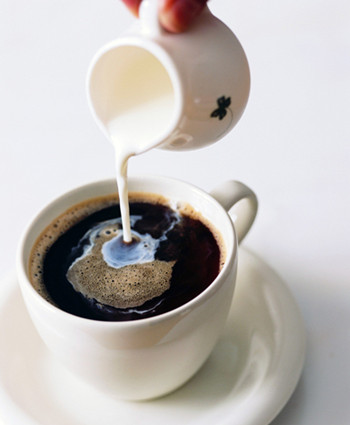Introduction of coffee excipients introduction of companion varieties of black coffee

Coffee companion:
Apart from coffee, it is hard to find a thing that can live in peace with so many lovers.
If the strong bitter black coffee is the devil of charm, then cream and sugar, like the wings of angels, bring sweet warmth close to heaven. Westerners call cream and sugar coffee-mate, but when coffee has more and more flavors, such as fresh cream, chocolate and cinnamon. And other ingredients, have also become a fixed scenery on the coffee shop table, black coffee is no longer a loyal companion, but to please more fastidious mouth.
The knowledge of water
Water can be roughly divided into soft water and hard water. After calculating the amount of sodium and manganese dissolved in water, the amount of soft water is less and the amount of hard water is more.
General water is hard water containing sodium, manganese, calcium, magnesium, etc., because hard water will release caffeine and tannin, which greatly reduces the taste of coffee. Ordinary tap water can be used as soft water, but the first tap water in the morning, the water taken the day before and the second boiled water should be avoided as far as possible. If you use water purifier and activated carbon filter, you can also avoid impurities and odors in the water. Therefore, as long as the use of fragrant and fresh coffee, the tap water available at home can also make mellow and delicious coffee.
Sonata for Sugar and Coffee
Cube sugar, granulated sugar, fine granulated rock sugar, black sugar, coffee sugar. The sweetness of different ingredients make a richer journey of coffee taste. You can follow your favorite coffee style to find the sweetness that suits you: the purpose of adding sugar to coffee is to ease the bitterness and create a completely different flavor depending on the amount of sugar.
1. Powdered sugar: it belongs to a refined sugar, has no special taste, is easy to dissolve, and is usually easy to use in a small package of 5 to 8 grams. The price is a little higher than ordinary sugar.
two。 Sugar cube: add water to the refined sugar and then solidify it into a lump. The cube sugar is easy to preserve and easy to dissolve.
3. White granulated sugar: White granulated sugar is also a refined sugar, it is coarse crystal solid, white color. There are more than 8 grams of small packaging in the market for each use.
4. Black sugar: this is a kind of brown sugar, a bit scorched, commonly used in the preparation of Irish coffee.
5. Rock sugar: transparent and crystalline, light sweetness and insoluble. It is usually ground into fine particles for use in drinks such as coffee or flavored tea.
6. Coffee sugar: sugar used specifically for coffee, brown sugar or cube sugar. Coffee sugar stays sweeter on the tongue than other sugars.
Coffee and milk
Choosing different milk products can give the coffee a different flavor and enjoy the varied taste.
1. Fresh cream: also known as whipped cream. This is a high concentration of cream that separates fat from fresh milk and has a wide range of uses, such as making butter, ice cream, cakes, or making coffee. The highest fat content of fresh cream is 45% ~ 50 and the lowest is 25% ~ 35. Coffee is usually made with whipped cream with a fat content of 25% ~ 35.
two。 Whipped cream: whipped cream turns into foamed cream after stirring and foaming. This cream tastes best with bitter espresso.
3. Condensed milk: concentrate milk one or two. Five times, it becomes sugar-free condensed milk. Generally speaking, canned condensed milk sold in stores is heated and sterilized, but it is easy to rot after opening cans and cannot be preserved for a long time. When brewing coffee, whipped cream floats a layer of oil on the coffee, while condensed milk precipitates into the coffee.
4. Milk and cream: milk is suitable for blending espresso or fancy coffee, while cream is easy to use and easy to preserve. But no matter what kind of product you use, you can make a delicious cup of coffee according to your personal preference.
When fresh cream is added to coffee, if there is a feathery oil on the surface, this is due to the phenomenon of fat separation when high-fat fresh cream is added to sour coffee or when stale dairy products are used. So in addition to paying attention to the freshness of dairy products, high-fat whipped cream should be mixed with coffee with a mild sour taste.
Coffee-other spices
Coffee varies according to people's feelings and preferences, so there are many different ways to drink coffee. At the same time, a variety of additives are used to improve the taste of coffee.
1. Spices: cinnamon (divided into powder or stick), cocoa, cardamom, mint, cloves, etc., of which cinnamon can be often used in cappuccino.
two。 Fruit: oranges, lemons, pineapples, bananas, etc., used for fancy coffee seasoning and decoration, enriching the alternative enjoyment of coffee.
3. Alcohol: brandy, whisky, rum, peppermint liqueur, etc., is the magician of fancy coffee.
Important Notice :
前街咖啡 FrontStreet Coffee has moved to new addredd:
FrontStreet Coffee Address: 315,Donghua East Road,GuangZhou
Tel:020 38364473
- Prev

Coffee Common Sense 7 principles for making the perfect cup of coffee
Here are seven simple rules for making good coffee: A. Use freshly roasted coffee beans and store them for up to a week, preferably half an hour before roasting. B. Store coffee beans in a container protected from light. C. Freshly ground coffee beans before brewing. D. Put the tap water for a few seconds before use, and then use fresh cold water from the tap to
- Next

Coffee making process The elements of making a good cup of coffee
The elements of making a good cup of coffee: A. To have a very good coffee raw material, namely coffee beans B. Good and functional coffee facilities C. Coffee makers need to know how to do it properly. I. Coffee knowledge The two most common coffee varieties on the market are Arabica coffee and Roberta coffee. Arabica coffee grows at higher altitudes.
Related
- Beginners will see the "Coffee pull flower" guide!
- What is the difference between ice blog purified milk and ordinary milk coffee?
- Why is the Philippines the largest producer of crops in Liberia?
- For coffee extraction, should the fine powder be retained?
- How does extracted espresso fill pressed powder? How much strength does it take to press the powder?
- How to make jasmine cold extract coffee? Is the jasmine + latte good?
- Will this little toy really make the coffee taste better? How does Lily Drip affect coffee extraction?
- Will the action of slapping the filter cup also affect coffee extraction?
- What's the difference between powder-to-water ratio and powder-to-liquid ratio?
- What is the Ethiopian local species? What does it have to do with Heirloom native species?

